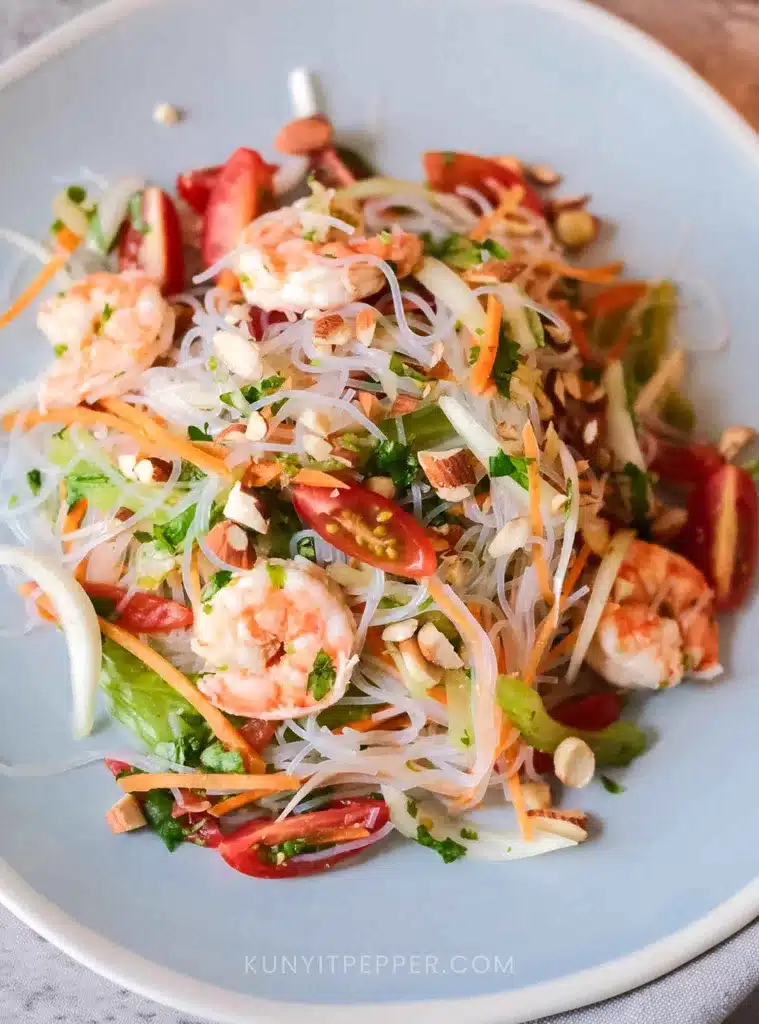
About this Healthy Glass Noodle Salad with Celery
Refreshing and bold, this mung bean vermicelli salad combines sweet and sour with a subtle kick of spiciness. (I omit the spiciness sometimes).
It’s that type of hydrating salad where every bite gives you a crispy texture and juicy sweetness from the Vitamin C ingredients. And it’s gluten-free too!
It’s very minimal cooking needed to make this Asian glass noodle salad, which is one of the reasons this is my go-to light meal.
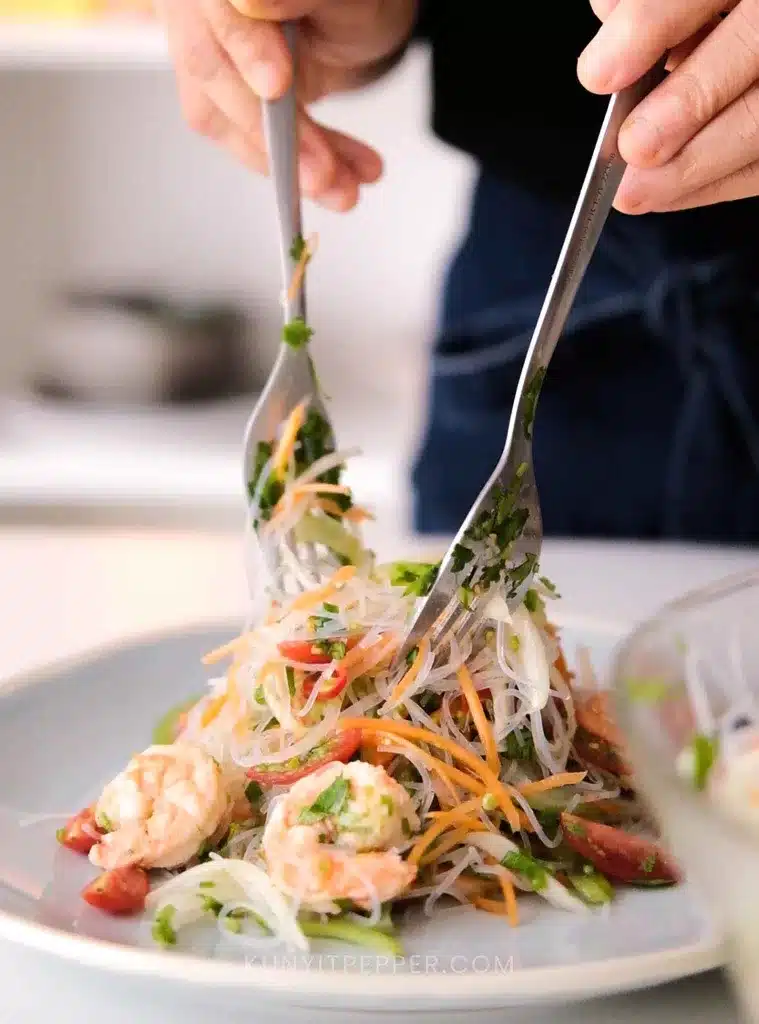
You will only need to boil the noodles for 3 minutes and another 2-3 minutes for the protein. 6 minutes of cooking in total, using the same pot of boiling water, it’s really not bad for a quick and nutritious meal.
🌱 Swap the prawn with boiled edamame instead for a vegan variation or if you have an allergy to seafood.
This low-calorie noodle salad is versatile. You can enjoy it as a light main dish since it can be a complete meal on its own. Or have it as a side salad alongside any main dish.
I make the ingredients flexible so you can substitute them based on your dietary needs or accessibility.
As someone who grew up with Southeast Asian foods, I’ve figured that small substitutions to more wholesome ingredients help me gradually shift toward healthier eating.
For me, it’s a more sustainable way to eat well without entirely giving up the foods that give me comfort.
Main ingredients to make this Thai Healthy Glass Noodle Salad with Celery
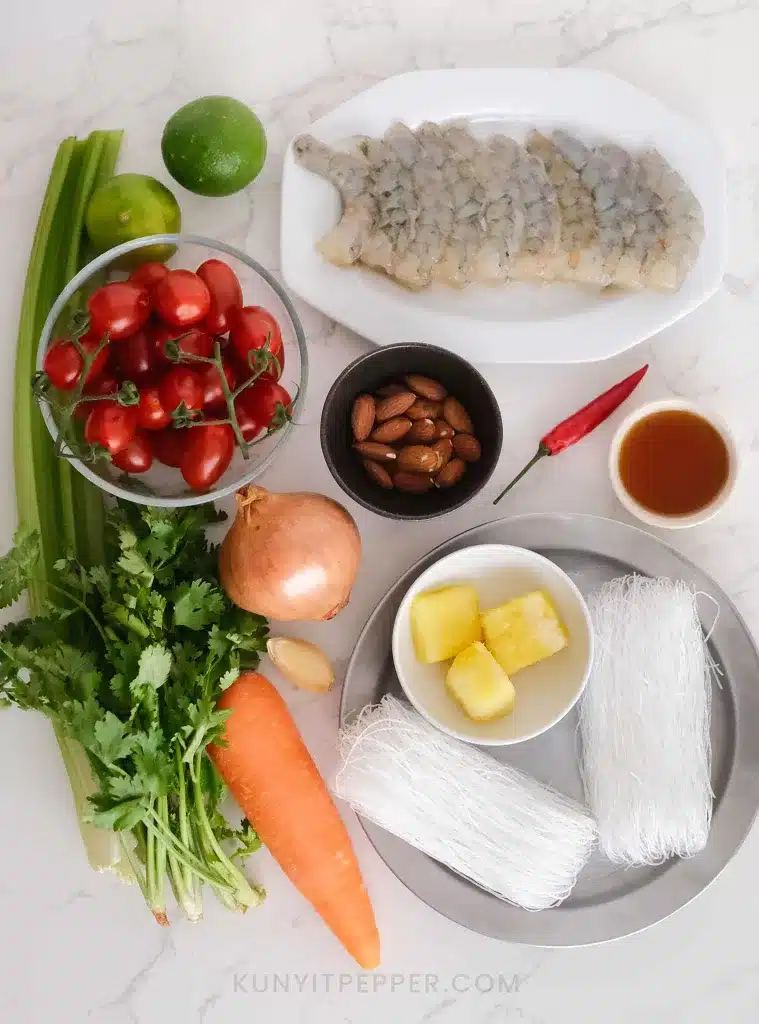
- Glass Noodle/Mung Bean vermicelli—This noodle is easily mistaken for rice vermicelli due to its size and texture. Glass noodle is made of mung bean, and it’s translucent in color compared to rice vermicelli, which is more cloudy.
- Prawns—Remove the skin and head and devein before boiling. Boiling prawns in boiling water will take you 2-3 minutes max. Longer than that, the prawns will get tough and dry. I’m using the same boiling water I use for noodles right after straining them to dry.
- Cherry tomatoes/Tomatoes—You can use either cherry tomatoes or normal-size tomatoes. I like cherry tomatoes more for this salad because they are sweeter and easier to manage.
- Celery—If the celery comes with the leaves, add some to the salad for extra flavor.
- Yellow onion—Sweeter and milder than red onion, I find it balances well with the celery without overpowering other ingredients.
- Coriander—Use both the stems and leaves. Coriander stems hold many health benefits and flavors you don’t want to miss. Chop the stem as fine as you can for an even spread, while the leaves can be roughly chopped.
- Carrot—Chop them into super thin Julienne.
- Almonds—If you’re allergic to nuts, skip this. Almonds have the highest fiber, and they are more nutrient-dense than those two. Do include the skin as it holds antioxidants and anti-inflammatory benefits. Traditionally, roasted peanuts or cashew nuts are used for garnishing. Feel free to use your favorite option.
✏️ Antioxidant – Natural substances that help protect cells from damage, potentially reducing the risk of chronic diseases.
Dressing ingredients & substitution
- Pineapple juice frozen cube (My homemade sweetener) – I typically make this in bulk by blending fresh pineapple in a blender and pouring it into an ice cube mold to freeze without straining the puree. I like this in a salad or sweetener for salad, tea, and lightly cooked meals.
Substitute
1. Organic coconut amino—This sauce is commonly used as a gluten-free and low-sodium swap to other sauces like soy sauce and seafood sauce. It’s derived from coconut sap and tastes sweeter than a regular soy sauce or seafood sauce.
Since it’s sweet, it can also be used as a natural sweetener. Coconut Aminos can be found at an organic food mart or health market.
2. Pomegranate molasses—Although it’s more of a West Asia or Middle Eastern way of sweetening, this sauce adds both a sweet and sour taste to the salad, which fits the flavor profile of this glass noodle salad.
Plus, it comes with additional antioxidant benefits. However, like coconut amino, since they are dark in color, it’ll turn your glass noodles salad to be darker.
3. Palm sugar—When it comes to sugar in granule form, I like to use organic palm sugar and coconut sugar because they are less processed than white sugar.
4. Monk fruit sweetener—This natural sweetener is derived from the fruit of the monk fruit tree. Natively from China. This sweetener shows some antioxidants and anti-inflammatory benefits when taken in the right dose.
- Fish sauce—I like using red boat fish sauce due to its purest form of anchovie extract. It tastes stronger (umami and saltiness), so you don’t need so much—quality over quantity.
Due to the saltiness, you don’t need to add more salt. The fish sauce comes with some iodine that our body needs. Unless you are allergic to iodine, I suggest using salt instead.
Substitute
1. Salt- A gluten-free, vegan, most natural form of adding saltiness.
2. Kombu extract- A vegan version of iodine source—kombu extract derived from a kelp called kombu. It’s a vegan substitute to get the rich umami and iodine source.
Kombu extract is much milder than fish sauce in taste, and it’s not salty at all, so you will need to add salt to it.
3. Ground, dried anchovies—This is the easiest way to get that salty umami flavor. I use this to flavor other foods, too. It’s like my pure fish bullion in a coarse powder form.
Dried anchovies are typically salty but still far from the saltiness of fish sauce. So you might need to add salt to reach the desired saltiness, however it is optional.
- Fresh Garlic—Finely grate the garlic with a grater to release the maximum flavor and for an even spread. Stick with fresh garlic instead of powdered version for a natural flavoring and a source of anti-inflammatory properties.
- Key lime/Green lime—For authentic tropical salad or Thai flavor tastes, go with key lime. But if you just want the sourness and the Vitamin C benefits, feel free to use lemon. Note that the citrusy aroma in key lime green is different than lemon.
- Bird’s eye chili—Chop it as thin as you can. This chili can be too spicy for those who can’t tolerate spicy much, so chop it thinly to help spread it evenly. Feel free to reduce the amount or completely omit it.
How to make Healthy Glass Noodle Salad with Celery
1. Prep the vegetables.
Wash, dry, and cut all the vegetables. (Check the ingredients on the recipe card below.)

2. Boil noodles & prawns
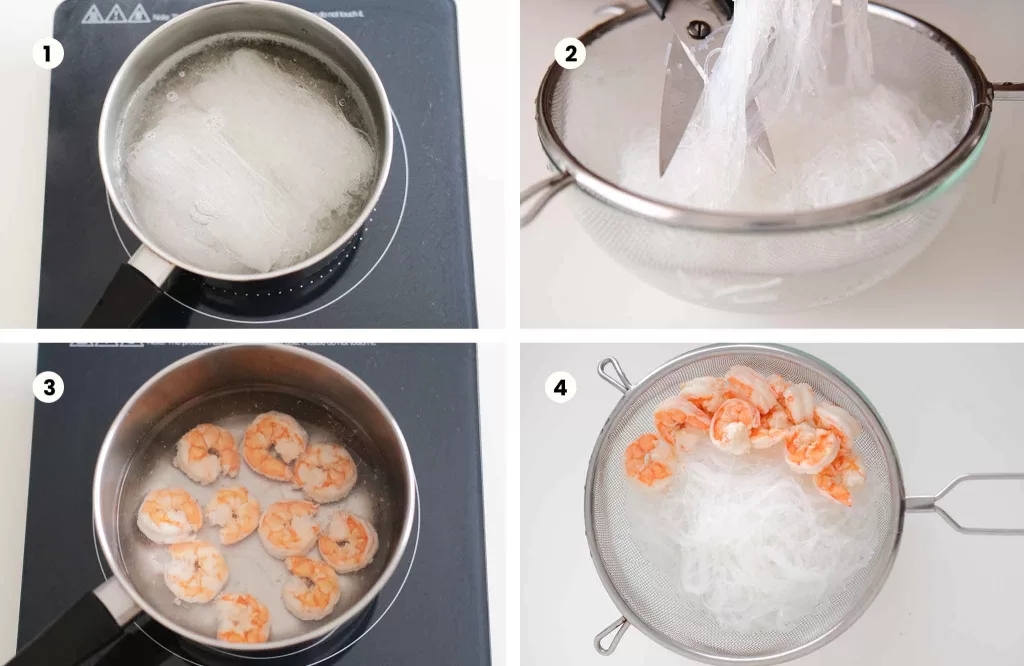
- Drop the noodles into simmering hot water and let it boil for 2-3 minutes. Packaging instructions may vary, so make sure to follow the guide.
- Fish out the noodles using a strainer while keeping the water boiling, and cut the noodles with scissors into finger lengths.
- Bring in the prawns and cook until they turn orange, about 2 minutes.
- Strain the prawns and transfer them next to the noodles.
3. Mix the dressing
In a small bowl, mix all the dressing ingredients with a spoon until fully incorporated.

4. Combine and garnish
Mix all ingredients with forks and garnish with chopped almonds.
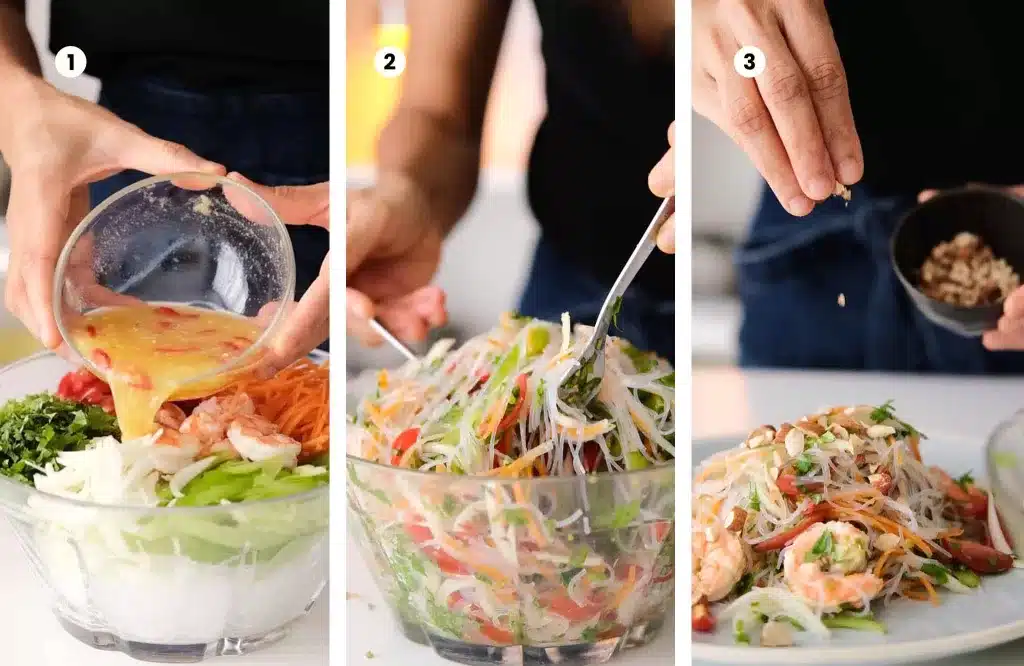
What to eat with this Thai Healthy Glass Noodle Salad with?
Apart from enjoying them alone, this salad will be a great side dish to eat alongside other foods. In Thailand, this glass noodle salad is often a side salad dish, commonly served next to jasmine rice and other Thai dishes. But here are some ideas on how you can eat this salad the healthy way:
- Make a lettuce boat to enjoy them with added fiber. This is my favorite and easiest daily way of pairing this salad.
- Enjoy alongside protein-based food. This salad makes a great side dish for barbecue dishes. Because of its refreshing sweet and sour flavor, it helps cleanse the palate.
- Wrap it in rice paper and make fresh rolls. Since this noodle salad can be watery, consider draining them first and reuse that dressing water for dipping sauce. This will be a great appetizer, especially when hosting guests.
Recipe that I pairs well with this glass noodle salad
- Oven-steamed fish with garlic, ginger and lime
- Hot and Sour Chicken Tom Yum / Tom Yam Ghai
- Vegan Tom Yum / Tom Yum Kha with coconut milk
Making this salad ahead
This Thai Healthy Glass Noodle Salad is the type of salad you would enjoy within a day. Since vermicelli noodles tend to absorb water, it can get quite soggy sitting too long with the dressing.
In contrast, if you keep them dry in the fridge, it tends to harden. So make it for lunch so you can enjoy it for dinner too.
It tastes better during dinner time after the noodles are marinated with the dressing.
How many calories are in this glass noodle salad?
The total calories of this healthy glass noodle salad are approximately 633 kcal.
The serving size is 4, and therefore, calories per serving is 158 kcal.
To soak or boil glass the glass noodles?
To soak or boil the glass noodles, depending on what you plan to do with them. Soaking is required to slightly soften the noodles (typically before cooking), but it does not make them ready to eat.
For example, soak prior stir-frying or making a noodle soup.
While some glass noodles or mung bean vermicelli packaging instructions call for soaking, I prefer boiling or precisely blanching because it’s way faster.
Like in this healthy glass noodle salad recipe, the noodles must be cooked (boiled) until softened.
Let’s say if i’m making stir-fried noodles instead, and I want to save time from the long soaking, I’d boil it first until half soft.
Other recipes like this you might like
- Spicy Corn and Cucumber Salad – anti-inflammatory
- Thai Mango Salad
- Zesty Pineapple Salad- High Vitamin C
- Mediterranean cucumber and tomato salad
- Sumac Salad – Anti-inflammatory
Thai Healthy Glass Noodle Salad with Celery + Wholesome Dressing Substitutes
4
servings10
minutes5
minutes633
kcal158
kcalThai-style healthy glass noodle salad that combines low-calorie mung bean vermicelli, celery, tomato, coriander, and onion with sauce high in Vitamin C and garnished with roasted almond.
Ingredients
100g of mung bean glass noodles
1 cup cherry tomato – Cut into wedges
2 stalks celery – Thinly sliced
1 medium carrot – Cut into thin Julienne
1 medium onion – Thinly sliced
70g of coriander – Finely chopped the stems and leaves
120g of prawns – Skinless & deveined
- Dressing
3-4 cubes of frozen pineapple juice / 100ml – (Check substitution above)
1 clove of fresh garlic – Grated
3 tbsp of freshly squeezed key lime juice
2 tbsp of Red Boat fish sauce – (Check substitution above)
- Garnishing
1/4 cup of roughly chopped roasted almonds – (Check substitution above)
Directions
- Boil noodles & prawns
- Drop the noodles into simmering hot water and let it boil for 2-3 minutes. Packaging instructions may vary, so make sure to follow the guide.
- Fish out the noodles using a strainer while keeping the water boiling, and cut the noodles with scissors into finger lengths.
- Bring in the prawns and cook until they turn orange, about 2-3 minutes.
- Strain the prawns and transfer them into the strainer next to the noodles.
- Make the dressing
- In a small bowl, mix all the dressing ingredients with a spoon until fully incorporated.
- Combine and garnish
- In a salad bowl, mix all ingredients with forks and garnish with chopped almonds before serving.
Notes
- Serve immediately for the best flavor and texture. Consume within one day (lunch and dinner), as the glass noodles tend to harden if left in the fridge overnight.
🥣 Did you try this recipe? Let me know your thoughts in the comment below.


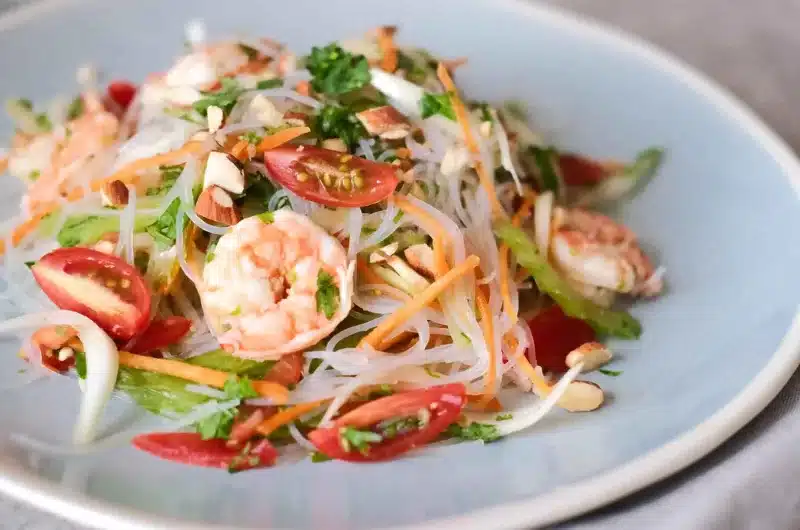





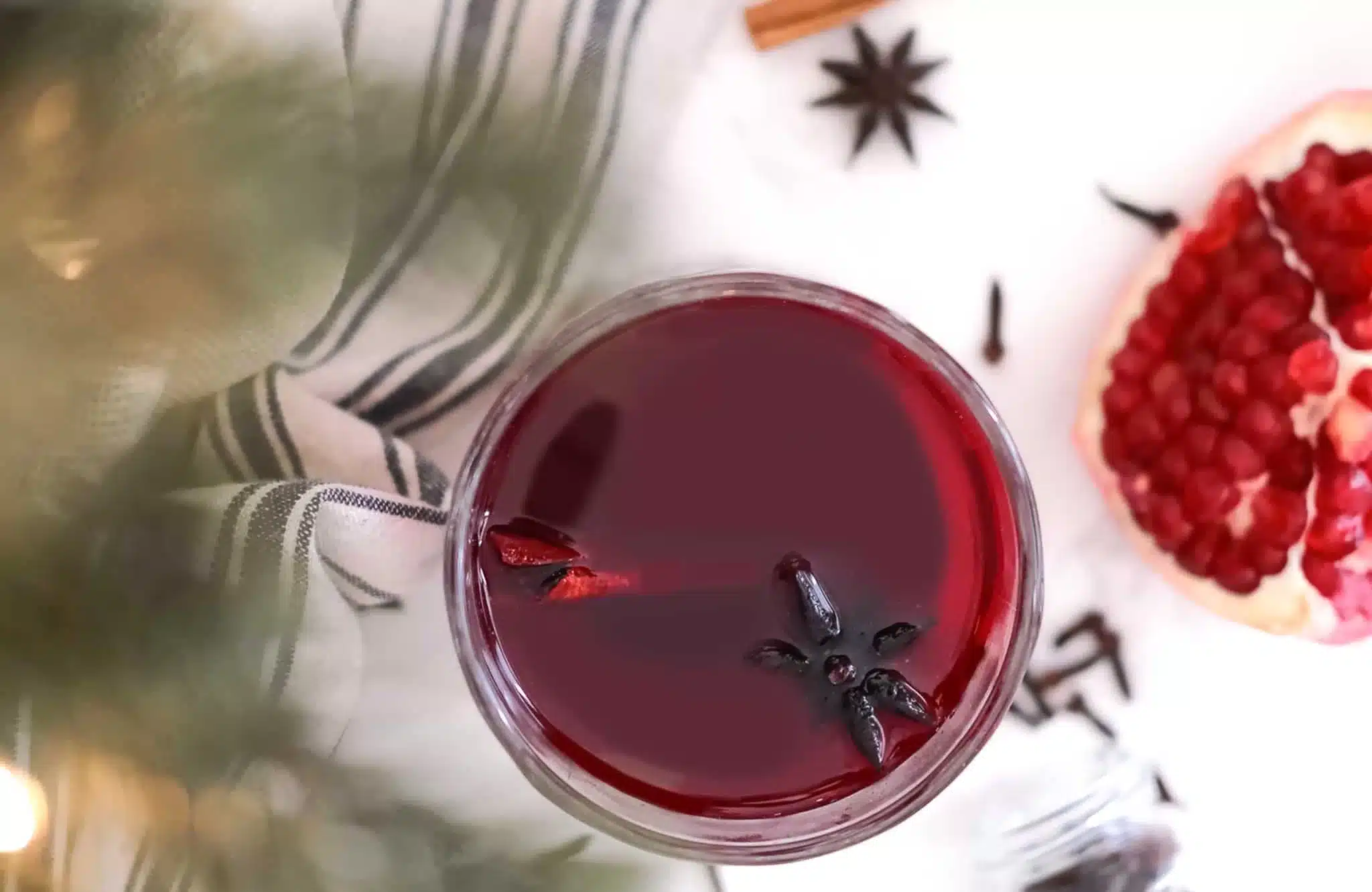
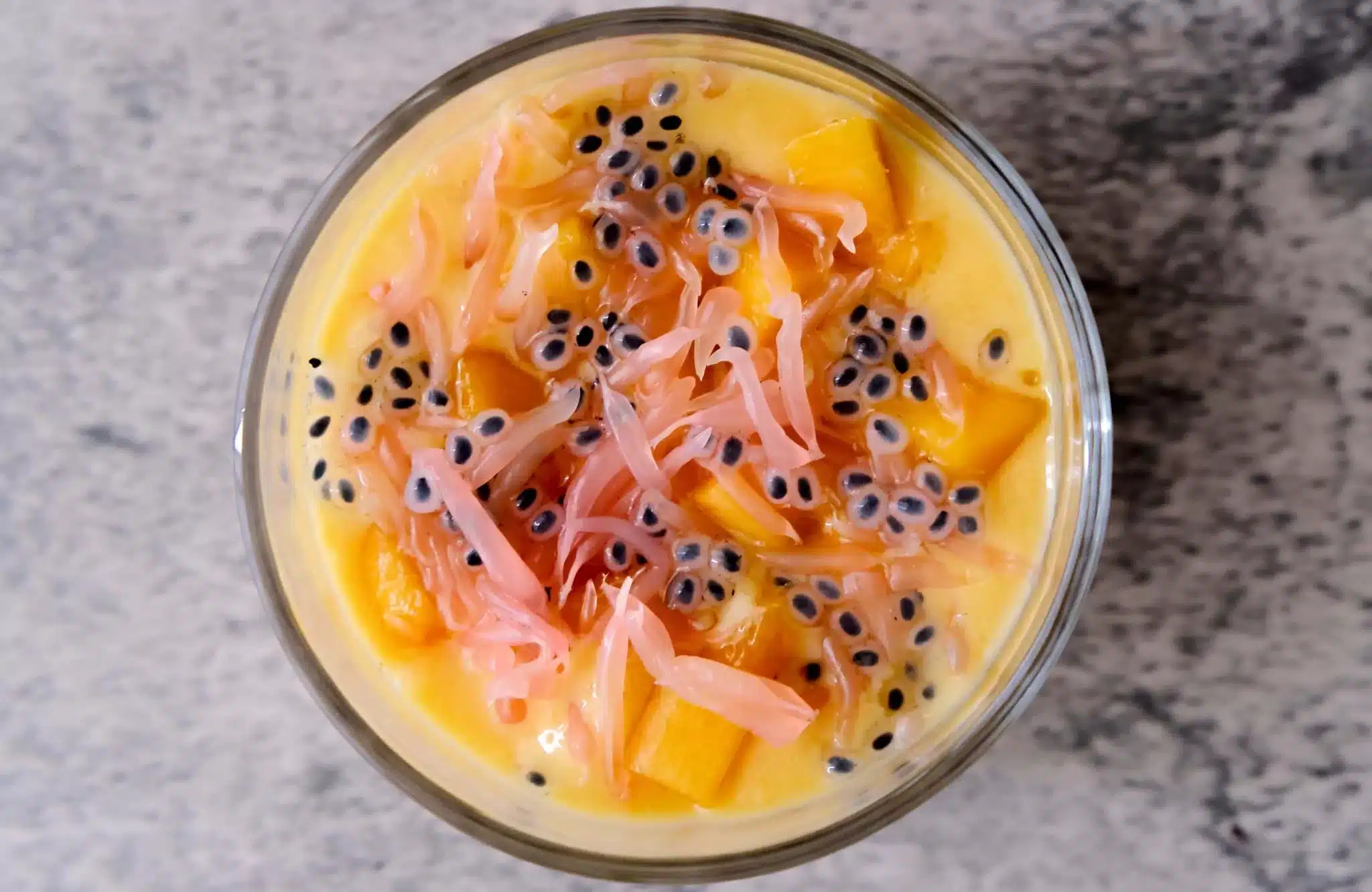
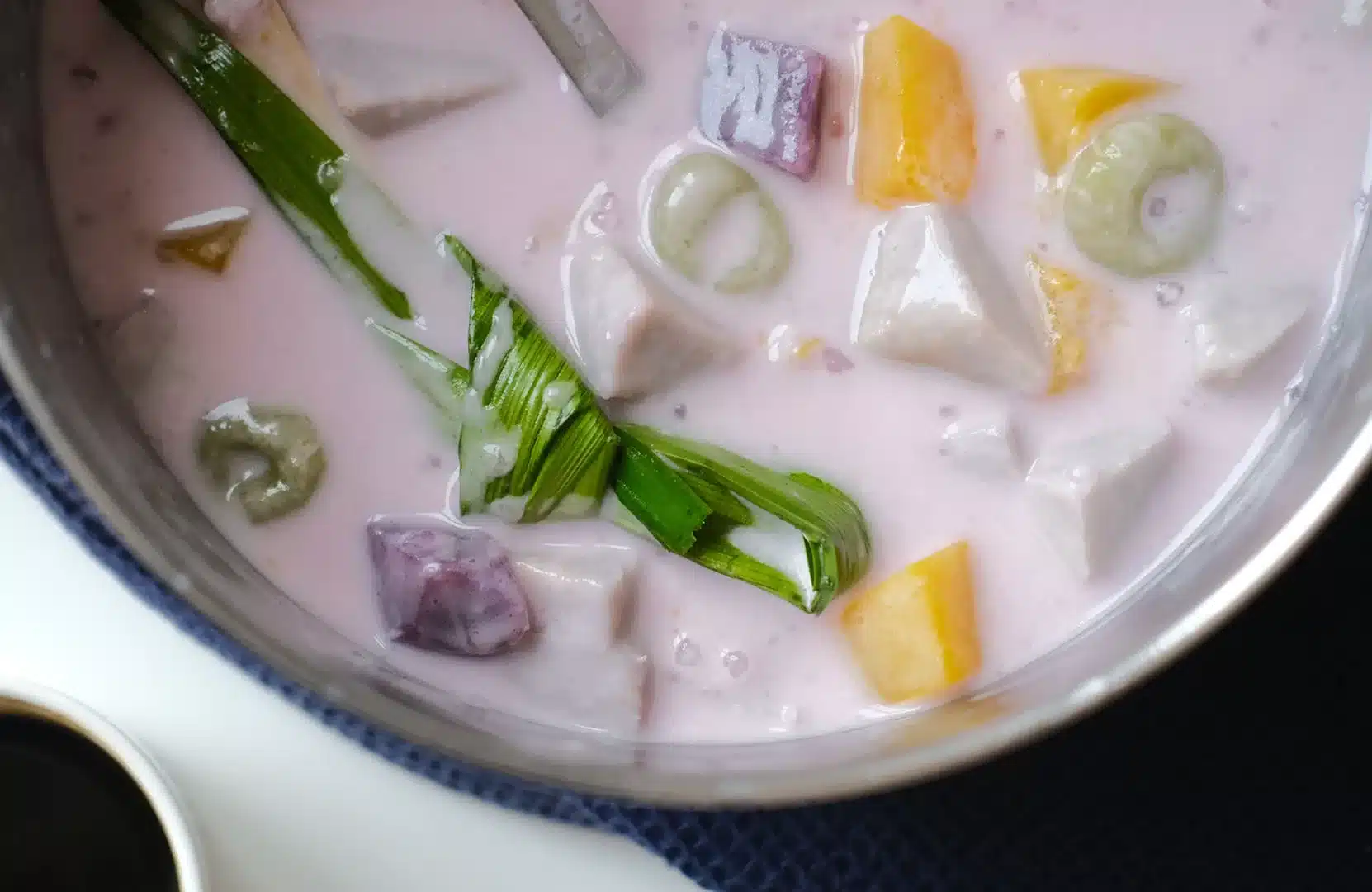

2 Responses
Love this recipe!
I didn’t have all the ingredients readily available – next time I will be more fully prepared – but I didn’t want to wait. But even without the carrots and chiles, the flavor was excellent and savory. I love your idea of pineapple juice frozen as a sweetener and will try this going forward. I swapped out the chili (which I didn’t have) for red pepper flakes and it gave a nice little punch of hot every so often without being overpowering. I didn’t have pomegranate molasses, but swapped out (to taste) regular molasses. This reminds me of the mango salad I used to eat daily when I lived in Cambodia. This will be my new go-to for lunch! Thank you for the inspiration and delicious salad recipe!
Hello Jen, I’m glad you loved the recipe, and I appreciate you sharing your swaps! I’ve never tried it with regular molasses, but I’m glad it worked. And yes, frozen pineapple juice as a sweetener is such a game-changer! Adding fruit to salads has actually helped me eat more of them. Thanks again for your kind words!